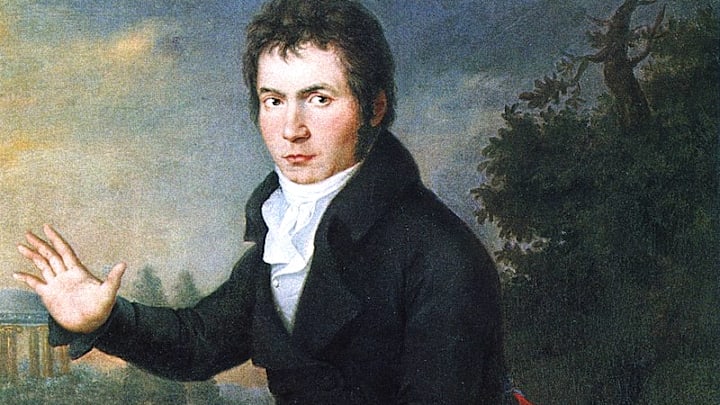While specific events in history have played a major part in the disappearance of many classical works of art, literature, and music (the burning of the Library at Alexandria, for instance), sometimes these things are lost to time, poor preservation, or deliberate destruction. And sometimes, they eventually show up in unexpected places or under interesting circumstances, like these six did.
1. La Royale Maison de Savoie // Alexandre Dumas

Alexandre Dumas, author of The Three Musketeers, The Count of Monte Cristo, and other wildly popular novels, was occasionally pressed to write something quickly for money. This seems to be the case with La Royale Maison de Savoie (The Royal House of Savoy), a 2500-page story that was serialized in the magazine Le Constitutionnel in 1854. It was so rushed, in fact, that neither the National Library of France nor the Alexandre Dumas Museum had any knowledge of it. Two historians browsing an antique bookstore in Turin, Italy, discovered it in 1998; since then, it has been published again in France.
2. Profile of a Young Fiancée // Attributed to Leonardo da Vinci

This chalk and ink portrait of a young woman in Renaissance garb was initially thought to have been drawn by an unknown artist, probably in Germany in the 19th century. In 1998, Profile of a Young Fiancée sold to a private collector for a surprisingly high $21,850 at a Christie’s New York auction. Over the next 10 years, a team of experts including Nicholas Turner, the former curator of drawings at the J. Paul Getty Museum in Los Angeles, closely examined the work and determined portrait was probably drawn by Leonardo da Vinci around 1485 (and may be depicting the Milanese noblewoman Bianca Maria Sforza). The attribution to Leonardo remains controversial, though. If it’s truly a Leonardo original, its value today could be well over $100 million.
3. “War Thoughts at Home” // Robert Frost

This 35-line poem by Robert Frost remained unknown to all but his friend Frederic Melcher, a book dealer, until 2006—88 years after it was written. Melcher donated his collection of the poet’s letters and books to the University of Virginia; the items hadn’t even been cataloged when Robert Stilling, a graduate student, heard about them. While skimming through the stacks, Stilling came across correspondence from 1947 describing an unpublished poem written by Frost. Curious, Stilling began looking through the collection and, within minutes, found “War Thoughts at Home” scrawled inside a copy of Frost’s 1914 book North of Boston, an inscription Melcher had deemed “really not important” in his letter to a museum asking for interesting items.
4. Trio in E Flat Major // Ludwig van Beethoven
Ludwig van Beethoven composed this untitled work for violin, viola, and cello in 1792, then rearranged it for piano, violin, and cello about eight years later. With only the first movement and 43 measures of the second movement completed, the project was abandoned and subsequently lost for over 100 years. German musicologist Willy Hess published the handwritten manuscript in a scholarly review in 1920, garnering almost no attention from working musicians. The first known performance of the 12-minute piece was on March 1, 2009—almost 182 years after Beethoven’s death. For the occasion, the Beethoven Project Trio borrowed a 1703 Stradivarius violin and 1739 Guarnerius cello, both made long before Beethoven was born in 1770.
5. With Custer on the Little Bighorn // William O. Taylor

William Othniel Taylor was member of the cavalry detachment serving under Major Marcus Reno at the infamous Battle of the Little Bighorn in June 1876. He took part in the initial attack on the Lakota and Cheyenne camp along the Little Bighorn River and survived the utter defeat, three days later, of George Armstrong Custer’s forces.
Taylor wrote his personal account of the battle around 1917, six years before he died, and stored it in a metal box, which his wife later gave to her niece in Connecticut. The manuscript became part of a museum’s archives that was auctioned off in the mid-1990s. Editor Greg Martin bought the manuscript and published it for the first time in 1996.
6. Panels from Struggle: From the History of the American People // Jacob Lawrence

After being purchased by a private collector, this 30-panel narrative work by Jacob Lawrence, the leading Black modernist artist of the 20th century, was auctioned off piece by piece in the 1960s. The whereabouts of many of the panels remained unknown for decades, until a 2020 exhibition of Lawrence’s work at the Metropolitan Museum of Art in New York rekindled interest in the artwork. A visitor to the exhibition came to a shocking realization: She thought she had seen one of the missing panels hanging on the wall in her elderly neighbors’ living room. Museum experts examined the work and deemed it the long-lost Panel 16, depicting the Revolutionary War-era Shays’ Rebellion; the owners had bought it at a neighborhood charity auction in 1960.
Amazingly, the news of that find prompted another one. A nurse on the Upper West Side read about the rediscovery of Panel 16 and thought it looked pretty similar to painting that had been hanging in her dining room for 20 years, a gift from her mother-in-law. Experts later concluded that the work was the errant Panel 28, a painting of people immigrating to America that Lawrence titled The Emigrants — 1821-1830 (106,308). Three more panels in the 30-part Struggle series are still missing.
A version of this story was published in 2009; it has been updated for 2024.
